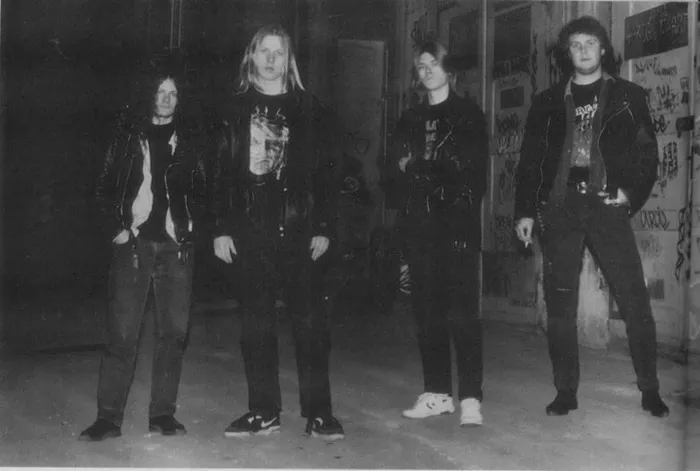Swedish death metal, a subgenre of death metal, emerged from Sweden in the late 1980s and early 1990s. It is renowned for its distinctive sound characterized by melodic guitar riffs, aggressive drumming, and guttural vocals. This genre has significantly influenced the global metal scene, contributing to the development of other subgenres and inspiring countless bands worldwide.
Origins and Evolution
Early Beginnings and Influences
Swedish death metal originated in the fertile metal scene of Sweden, drawing influence from early pioneers of death metal, thrash metal, and hardcore punk. Bands like Venom, Slayer, and Bathory, along with the burgeoning grindcore movement, played a pivotal role in shaping the sound that would come to define Swedish death metal.
The Rise of the Scene
The late 1980s saw the formation of seminal bands such as Nihilist (which later evolved into Entombed), Dismember, and Grave. These bands, alongside others, began to craft a unique sound that blended the raw aggression of death metal with melodic elements. This period also saw the establishment of Sunlight Studios in Stockholm, where producer Tomas Skogsberg played a crucial role in honing the signature Swedish death metal sound.
Characteristics of Swedish Death Metal
Guitar Tone and Riffs
One of the most defining features of Swedish death metal is the guitar tone, often referred to as the “buzzsaw” or “chainsaw” sound. Achieved through the use of the Boss HM-2 Heavy Metal pedal, this tone is characterized by its raw, overdriven distortion. The riffs themselves are typically melodic yet aggressive, incorporating tremolo picking and harmonized leads that create a sense of epic brutality.
Vocals
The vocal style in Swedish death metal is typically low-pitched and guttural, providing a stark contrast to the melodic elements of the guitar work. This vocal approach is designed to evoke a sense of primal aggression and despair, aligning with the often dark and macabre themes of the lyrics.
Drumming and Rhythm Section
The drumming in Swedish death metal is aggressive and dynamic, featuring rapid double bass patterns, blast beats, and complex fills. The rhythm section as a whole works to provide a solid foundation for the melodic guitar work, creating a powerful and cohesive sound.
Notable Bands and Albums
Entombed
Entombed is often credited as one of the pioneering bands of Swedish death metal. Their debut album, “Left Hand Path” (1990), is considered a cornerstone of the genre, showcasing the signature guitar tone and blending melodic elements with brutal aggression. Subsequent albums like “Clandestine” (1991) further solidified their legacy.
Dismember
Dismember’s debut album, “Like an Everflowing Stream” (1991), is another seminal release in the Swedish death metal canon. Known for its intense riffing and dark, atmospheric production, this album has influenced countless bands within and beyond the genre.
Grave
Grave’s early works, particularly “Into the Grave” (1991), are essential listening for fans of Swedish death metal. The band’s heavy, groove-laden sound and guttural vocals exemplify the raw power of the genre.
At the Gates
At the Gates brought a more melodic approach to Swedish death metal, culminating in their classic album “Slaughter of the Soul” (1995). This release is often credited with helping to establish the melodic death metal subgenre, blending aggressive death metal elements with more accessible, melodic songwriting.
Impact and Legacy
Influence on Melodic Death Metal
Swedish death metal has had a profound influence on the development of melodic death metal, with bands like In Flames, Dark Tranquillity, and Arch Enemy drawing heavily from the pioneering sounds of the early Swedish death metal scene. These bands took the melodic elements and expanded upon them, creating a more accessible yet still aggressive form of metal.
Global Reach
The impact of Swedish death metal extends far beyond Sweden’s borders. Bands from around the world have cited Swedish death metal as a key influence, leading to a proliferation of bands and subgenres that incorporate its distinctive sound. This global reach has ensured that the legacy of Swedish death metal continues to thrive.
Continuing Evolution
While the core elements of Swedish death metal have remained consistent, the genre continues to evolve. Modern bands such as Bloodbath and Tribulation have taken the foundations laid by the pioneers and added their own unique twists, ensuring that Swedish death metal remains relevant in the contemporary metal landscape.
Cultural and Social Context
Swedish Metal Scene
The success of Swedish death metal can be partly attributed to the supportive and vibrant metal scene in Sweden. The country’s strong tradition of music education, combined with a robust network of clubs, festivals, and independent record labels, has provided fertile ground for the growth and development of metal music.
Themes and Lyrics
The lyrical themes in Swedish death metal often explore dark and macabre subjects, including death, war, and the supernatural. These themes are reflected in the music’s aggressive and intense sound, creating a cohesive and immersive experience for listeners.
Community and Identity
For many fans and musicians, Swedish death metal represents more than just a musical style; it is a community and a source of identity. The genre’s emphasis on authenticity and raw emotion resonates with listeners who seek an alternative to mainstream music.
See Also: Why Is Metal Music Soothing?
Conclusion
Swedish death metal is a genre that has made an indelible mark on the global metal scene. Its unique blend of melodic guitar work, aggressive drumming, and guttural vocals has inspired countless bands and led to the development of new subgenres. The legacy of Swedish death metal is one of innovation and influence, ensuring its place as a cornerstone of extreme metal music. As the genre continues to evolve and inspire new generations of musicians, the future of Swedish death metal looks as promising as its storied past.

